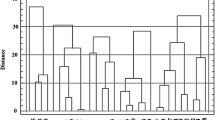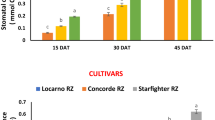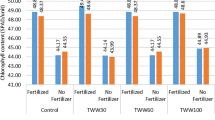Abstract
There are several climate indexes in viticulture for determining grape growing potential of a region and among these indexes, heat summation index is commonly employed to characterize grape growing regions on which the base temperature and the calculation period are based. In recent times, latitude-temperature index has been considered to be more accurate for deciding the suitability of a region in terms of grape growing. In current study, it was utilized from both heat summation index and latitude-temperature index for assessing of suitability of research region in terms of viticulture and also compared relationships among the climate parameters and quality characteristics of some table grape varieties grown in Tekirdağ ecological conditions during the two consecutive years (years 2015, 2016). As a result, the best grape quality characteristics among the grape varieties were respectively obtained from varieties of ‘Muscat Hamburg’, ‘Horoz Karası’ and ‘Cardinal’ in the years 2015 and 2016 and climatic indexes divulged that prevailing research region was quite convenient for viticulture. Furthermore, when the two years of the study were compared in terms of both climate indexes, it was especially found that 2016 year revealed better quality characteristics in grape varieties grown in Tekirdağ province, Northwestern Turkey compared to 2015 year.




Similar content being viewed by others
References
Amerine MA, Winkler AJ (1944) Composition and quality of musts and wines of California grapes. Hilgardia 15:493–675
Anonymous (2017) OIV statistics for world viticulture. Retrieved from http://www.oiv.int/en/databases-and-statistics/statistics. Accessed 23 April 2019
Azuma A, Yakushiji H, Koshita Y, Kobayashi S (2012) Flavonoid biosynthesis-related genes in grape skin are differentially regulated by temperature and light conditions. Planta 236:1067–1080
Bahar E, Korkutal I, Oner H (2018) Terroir elements in viticulture. Bahçe 47(2):57–70
De Blij HJ (1983) Geography of viticulture: rationale and resource. J Geogr 82(3):112–121
Boss PK, Davies C (2009) Molecular biology of anthocyanin accumulation in grape berries. In: Kalliopi ARA (ed) Grapevine Molecular physiology and biotechnology. Springer, Dordrecht Heidelberg, New York, pp 263–292
Caprio J, Quamme H (2002) Weather conditions associated with grape production in the Okanagan Valley of British Colombia and potential impact of climate change. Can J Plant Sci 82(4):755–763
Fraga H, Malheiro AC, Moutinho-Pereira J, Santos JA (2012) An overview of climate change impacts on European viticulture. Food Energy Secur 1(2):94–110
Fregoni C, Pezzutto S (2000) Principes et premieres approches de l’indice bioclimatique de qualite de Fregoni. Prog Agric Vitic 117:390–396
Gladstones J (1992) Viticulture and environment. Winetitles, Adelaide
Gougoulias N, Masheva L (2010) Effect of gibberellic acid (GA3) on polyphenols content and antioxidative activity of some table grape varieties. Oxid Commun 33:652–660
Hoffmann M (1991) Elektrochemische Merkmale zur Differenzierung von Lebensmitteln. In: Meier-Ploeger A, Vogtmann H (eds) Lebensmittelqualität – ganzheitliche Methoden und Konzepte – alternative Konzepte, vol 66. CF Müller, Karlsruhe, pp 67–86
Iland P (1987) Interpretation of acidity parameters in grapes and wine. Aust Grape Grow Wine Mak 5:81–85
Jackson DI, Cherry NJ (1988) Prediction of a district’s grape-ripening capacity using a latitude-temperature index. Am J Enol Vitic 39(1):19–28
Jackson DI, Schuster D (1987) The production of grapes and wine in cool climates. Butterworths of New Zealand, Wellington
Jones G, Davis R (2000) Climate influences on grapevine phenology, grape composition and wine production and quality for Bordeaux, France. Am J Enol Vitic 51(3):249–261
Jones GV, Duff AA, Hall A, Myers JW (2010) Spatial analysis of climate in Winegrape growing regions in the Western United States. Am J Enol Vitic 61(3):313–326
Kasimatis AN, Bearden E, Bowers K (1977) Wine grape varieties in North Coast Counties of California. Division of Agricultural Sciences, University of California, Publication 4069, 1–30, USA
Kenny GJ, Shao J (1992) As assessment of a latitude-temperature index for predicting climate suitability for grapes in Europe. J Hortic Sci 67(2):239–246
Kök D (2001) Effects of bioclimatological values of Tekirdag on growth, yield and quality of wine grape cultivars. Dissertation PhD. Thesis, Graduate School of Natural and Applied Sciences, Department of Horticulture. Trakya University, Edirne, p 139
Kok D, Bal E (2017) Electrochemical properties and biochemical composition of cv. Shiraz wine grape (V. vinifera L.) depending on various dose and application time of foliar microbial fertilizer treatments. Erwerbs-Obstbau 59:263–268
Kök D, Çelik S (2003) Determination of heat summation requirements of some wine grape cultivars and its effect on quality characteristics. Sci Res J Trakya Univ 4(1):23–27
Koufos GC, Mavromatis T, Koundouras S, Jones GV (2017) Response of viticulture-related climatic indices and zoning to historical and future climate conditions in Greece. Int J Climatol 38(4):2097–2111
Laszlo JC, Saayman D (1990) Optimum harvesting stage for Sultanina as table grape. Decid Fruit Grow 40:101–105
Liang S, Shakel K, Matthews MA, Miller E, Weis N, Thomas T (2005) Different growing conditions affect the firmness, diameter, sugar concentration, pH and tartaric acid on table grapes and wine grapes. Department of Pomology, University of California, Davis
Mullins MG, Bouquet A, Williams LE (2007) Biology of the grapevine. Cambridge University Press, p 239
Pastore C, Dal Santo S, Zenoni S, Movahed N, Allegro G, Valentini G, Filippetti I, Tornielli GB (2017) Whole plant temperature manipulation affects flavonoid metabolism and the transcriptome of grapevine berries. Front Plant Sci 8(929):1–16
Singleton VL, Timberlake CF, Kea L (1978) The phenolic cinnamates of white grapes and wine. J Sci Food Agric 29:403–410
Di Stefano R, Cravero MC (1991) Metodi per lo studio deipolifenoli dell’uva. Riv Vitic Enol 2:37–45
Tonietto J, Carbonneau A (2004) A multicriteria climatic classification system for grape-growing regions worldwide. Agric For Meteorol 124(1):81–97
Winkler AJ, Cook JA, Kliewer WM, Lider LA (1974) General viticulture. University of California Press, Berkley
Çelik S, Kök D (2000) Evaluation of Tekirdað environment from the point of climatical indexes used in viticulture. 2nd International Symposium on New Technologies for Environmental Monitoring and Agro-Applications, Tekirdað, 18–20 October 2000, pp 421–425
Author information
Authors and Affiliations
Corresponding author
Ethics declarations
Conflict of interest
D. Kok declares that he has no competing interests.
Rights and permissions
About this article
Cite this article
Kok, D. Responses of Grape Quality Characteristics of Some Table Grape Varieties (V. vinifera L.) Grown in Northwestern Turkey to Heat Summation Index and Latitude-temperature Index. Erwerbs-Obstbau 62 (Suppl 1), 17–23 (2020). https://doi.org/10.1007/s10341-020-00487-w
Received:
Accepted:
Published:
Issue Date:
DOI: https://doi.org/10.1007/s10341-020-00487-w




